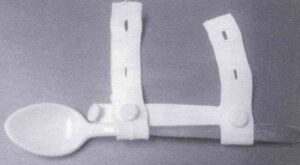Buncher

Because of visual impairment and/or motor problems, some children are unable to pick up an object again once they have let go of it. Since it is the repetition of grasping and letting go that lead to the ability of grasping and holding, the user will benefit from holding the object with the use of a buncher. This enables the user to grasp and let go whenever he/she wishes, to repeat the activity as many times as he/she needs, and to experiment with the duration of the grasp as well as the intervals between each repetition. Use of the buncher also permits the user’s hand to touch the surfaces of the objects, which allows him/her to experience the tactile qualities of the items. The buncher can be used to hold/grasp a variety of items including spoons, brushes, massagers, toys, or other items.
The Buncher is made from two pieces of buttonhole elastic (average length used is 4 ¾ inches), one piece of ½ or ¾ inch wide elastic, and two buttons. Three buttons can be sewn on the elastic strap if the Buncher is being used in a classroom with various sizes of hands.
The solid elastic without buttonholes should be approximately 3 ½ inches long, spanning across the back of the user’s hand. The buttonhole elastic should be long enough that it will loop around whatever object the user wishes to hold. “Fray Check,” a liquid seam sealant by Dritz (available at most fabric stores) can be applied to the ends of the elastic to prevent fraying.
References:
Lilli Nielsen, 1993, LilliWorks: Early Learning – Step by Step.
Videos Showing the Use of a Buncher
Jack Using a Buncher During Eating
In this video we see a little boy, Jack, using a spoon attached with a buncher to his hand as he practices bring the spoon to his mouth to take a bite.
Using a Hair Scrunchy as a Buncher
In this video Patty Obrzut demonstrates how to use a hair scrunchy to make a buncher.
Suppliers of Buttonhole Elastic
Many fabric stores have buttonhole elastic available for sale. If you can’t find it you may order it from Home Sew.
Home Sew
PO Box 4099
Bethlehem, PA 18018
1-800-344-4739
Directions to Make a Buncher
- Buttons should be sewn on solid piece of elastic, encompassing the width of the user’s hand.

2. The buttonhole elastic should loop around object.

3. The solid elastic is placed at the back of the user’s hand and the elastic wrapped around and secured with the buttons.

For more information contact:
Penrickton Center for Blind Children, 26530 Eureka Road, Taylor, MI 48180, Phone (734) 946-7500 or visit the Penrickton Center for the Blind website at www.penrickton.com.

